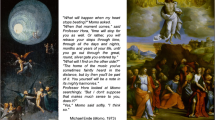Abstract
Prior hypotheses as to the etiology of near-death experiences (NDEs) have been limited to psychiatric explanations or brief discussions of endorphins as causative agents. We present a neurophysiological explanation for NDEs based on their similarities with lysergic acid-, ketamine-, and hypercapnia-induced hallucinations. We believe the core NDE is genetically imprinted and triggered by serotonergic mechanisms.
Similar content being viewed by others
References
Cahal, D.A. (1957). Effects of nalorphine on the behavior of healthy human volunteers.Journal of Mental Sciences, 103, 850–855.
Carr, D. (1982). Pathophysiology of stress-induced limbic lobe dysfunction: A hypothesis for NDEs.Anabiosis: The Journal of Near-Death Studies, 2, 75–90.
Collier, B. (1972). Ketamine and the conscious mind.Anesthesia, 27, 120–134.
Comer, N.L., Madow, L., & Dixon, J. (1967). Observations of sensory deprivation in a life threatening situation.American Journal of Psychiatry, 124, 164–167.
Domino, E.F., Chodoff, P., & Corssen, G. (1965). Human pharmacology of CI-581, a new intravenous agent chemically linked to phencyclidine.Federation Proceedings, 24, 268.
Ehrenwald, J. (1974). Out of body experiences and the denial of death.Journal of Nervous and Mental Disease, 159, 227–233.
Gabbard, G.O., & Twemlow, S.W. (1983).With the Eyes of the Mind. New York: Praeger.
Green, J.T., & Friedman, P. (1983). Near-death experiences in a Southern California population.Anabiosis:The Journal of Near-Death Studies, 3, 77–96.
Greyson, B. (1983). The psychodynamics of near-death experiences.Journal of nervous and Mental Disease, 6, 376–381.
Greyson, B., & Stevenson, I. (1980). The phenomenology of near-death experiences.American Journal of Psychiatry, 137, 1193–1196.
Grof, S., & Halifax, J. (1977).The Human Encounter With Death. New York: E.P. Dutton.
Judson, I.R., & Wiltshaw, E. (1983). A near-death experience.Lancet, 2, 561–562.
Meduna, L.T. (1950).Carbon Dioxide Therapy: A Neurophysiological Treatment of Nervous Disorders. Springfield, IL: Charles C. Thomas.
Moody, R.A., Jr. (1975).Life After Life. Covington, GA: Mockingbird.
Morse, M., Castillo, P., Venecia, D., Milstein, J., & Tyler, D.C. (1986). Childhood near-death experiences.American Journal of Diseases of Children 140, 1110–1114.
Morse, M.L., Connor, D., & Tyler, D. (1985). Near-Death experiences in a pediatric population.American Journal of Diseases of Children, 139, 595–600.
Noyes, R. (1979). Near-death experiences: Their interpretation and significance. In Kastenbaum, R. (Ed.),Between Life and Death (pp. 73–88). New York: Springer.
Penfield, W. (1955). The role of the temporal cortex in certain psychical phenomena.Journal of Mental Science, 101, 451–465.
Penfield, W. (1975).The Mystery of the Mind. Princeton, NJ: Princeton University Press.
Penfield, W., & Rasmussen, T. (1950).The Cerebral Cortex of Man: A Clinical Localization of Function. New York: Macmillan.
Ring, K. (1980).Life at Death: A Scientific Investigation of the Near-Death Experience. New York: Coward, McCann & Geoghegan.
Rogo, D.S. (1984). Ketamine and the near-death experience.Anabiosis: The Journal of Near-Death Studies, 4, 87–96.
Sabom, M. (1982).Recollections of Death: A Medical Investigation. New York: Harper and Row.
Snow, A.E., Tucker, S.M., & Dewey, W.L. (1982). The role of neurotransmitters in stress induced antinociception.Pharmacology Biochemistry and Behavior, 16, 47–50.
Strahlendorf, J.C.R., Goldstein, F.J., Rossi, G.V., & Malseed, R.T. (1982). Differential effects of LSD, serotonin, and L-tryptophan on visually evoked responses.Pharmacology Biochemistry and Behavior, 16, 51–55.
White, F., & Appel, T. (1982). Lysergic acid diethylamide and lisuride: Differentiation of their neuropharmacological actions.Science, 216, 535–536.
Winson, J. (1986).Brain and Psyche. New York: Random House.
Winson, J., & Abzug, C. (1977). Gating of neuronal transmission in the hippocampus.Science, 196, 1223–1225.
Winson, J., & Abzug, C. (1978). Neuronal transmission through hippocampal pathways dependent on behavior.Journal of Neurophysiology, 417, 716–722.
Author information
Authors and Affiliations
Rights and permissions
About this article
Cite this article
Morse, M.L., Venecia, D. & Milstein, J. Near-death experiences: A neurophysiologic explanatory model. J Near-Death Stud 8, 45–53 (1989). https://doi.org/10.1007/BF01076138
Issue Date:
DOI: https://doi.org/10.1007/BF01076138




